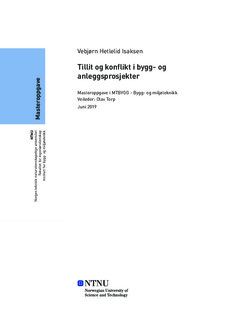| dc.contributor.advisor | Torp, Olav | |
| dc.contributor.author | Isaksen, Vebjørn Hetlelid | |
| dc.date.accessioned | 2019-11-06T15:04:38Z | |
| dc.date.available | 2019-11-06T15:04:38Z | |
| dc.date.issued | 2019 | |
| dc.identifier.uri | http://hdl.handle.net/11250/2627039 | |
| dc.description.abstract | Byggebransjen blir ofte omtalt som «40% sektoren». Dette kommer av at den bruker 40% av materialene, 40% av energien og står for 40% av utslippene. Dette er en helt sentral del av norsk næringsliv, og hvordan det går med byggenæringen kan få store konsekvenser for samfunnsøkonomien. Bransjen opplever en stadig nedgang i produktivtitet i tråd med at omfanget og kompleksiteten av prosjektene fortsetter å vokse.
En mulig faktor som påvirker produktivitetstapet er graden av konflikter. Aktørene i bransjen er enige om at konfliktnivået er for høyt og ønsker å iverksette effektive tiltak for å få bukt med problemet. Samtidig vet man for lite om omfanget, faktorene som utløser konflikter og hvordan dette skal håndteres. Det er et såkalt «forskningsgap».
I denne oppgaven skal disse faktorene undersøkes nærmere. Tidligere har det blitt undersøkt hva omfanget av konflikter er, og i denne oppgaven skal det undersøkes hvordan man kan løse dem. Undersøkelsene har en kvalitativ tilnærming hvor det gjennomføres intervju og dokumentstudier for å kartlegge nevnte faktorer. Samtidig vil sammenhengen mellom tillit og konflikt undersøkes nærmere.
Videre viser resultatene fra oppgaven en tydelig sammenheng mellom tillit og konflikt. Tillit er helt avgjørende for å unngå konflikter i et prosjekt og skape god samhandling. Dette skapes kun når man er villig til å akseptere usikkerhet og en økt risiko. De fleste konflikter oppstår som følge av uenigheter rundt kontraktene. Det er et skjevt maktforhold mellom partene på dette området og dette introduserer flere useriøse aktører som prioriterer penger over kvalitet.
Videre har det blitt identifisert seks sentrale faktorer for samhandling:
- Tidlig involvering
- Åpenhet og ærlighet
- Økt tillit
- Samhandlingsmøter
- God kommunikasjon
- Forankring i ledelsen
Dette er faktorer som primært er personrelaterte, og er forhold som direkte angår mennesker. Faktorene er avhengige av hverandre og det betyr at for å oppnå god samhandling er det ikke nok å oppfylle kun en av dem, man må oppfylle (nesten) alle.
Videre arbeid på området vil kreve en bedre kartlegging av prosjektspesifikke faktorer og deres innvirkning på konfliktnivået. Det må også forskes videre på bruk av «Lean» prinsipper til å redusere konflikter som f.eks. BVP og IPD. I tillegg burde det satses på å kvantifisere data med tanke på både omfanget av konflikter og faktorer som påvirker konfliktnivå i næringen
Nøkkelord: [Konflikt, Tvist, Omfang, Håndtering, Tillit, Anlegg] | |
| dc.description.abstract | The construction industry is often referred to as the "40% sector". This is because it spends 40% of the materials, 40% of the energy and accounts for 40% of the emissions. The industry is a central part of Norwegian business and industry, and the developments in the construction industry can have major consequences for the economy. The industry is experiencing a steady decline in productivity all the while the scope and complexity of the projects continue to grow.
One possible factor affecting the productivity loss is the degree of conflict. Industry professionals agree that the conflict level is too high and seeks to take effective measurements to overcome the problem. At the same time, one knows too little about the scope, the factors that trigger conflicts and how this should be handled. It is a so-called "research gap".
In this task these factors will be examined further. Previously, the extent of conflicts has been investigated, and in this thesis it will be investigated how to solve them. The research method is a qualitative approach where interviews and document studies are conducted to map the aforementioned factors. At the same time, the connection between trust and conflict will be examined in more detail.
Furthermore, the results of the assignment show a clear connection between trust and conflict. Having trust is absolutely crucial to avoid conflicts in a project and foster good cooperation. This will only be the case when one is willing to accept uncertainty and an increased risk. Most conflicts arise as a result of disagreements around the contracts. There is a skewed power-dynamic between the parties in this area and this introduces several less-serious players who prioritize money over quality.
Furthermore, six key factors for interaction have been identified:
- Early involvement
- Openness and honesty
- Trust
- Coordination meetings
- Good communication
- Anchoring management
These are factors that are primarily focus on the interactions between people. The factors depend on each other and that means that to achieve good interaction it is not enough to fulfill only one of them, one has to fulfill (almost) all of them.
Further work in the area will require a better mapping of project-specific factors and their impact on the level of conflict. There must also be further research on the use of "Lean" principles to reduce conflicts such as. BVP and IPD. In addition, there should be made efforts to quantify data regarding both the scope of conflicts in the industry and factors affecting the magnitude of conflicts in the industry.
Keywords: [Conflict, Dispute, Scope, Handling, Trust, Construction] | |
| dc.language | nob | |
| dc.publisher | NTNU | |
| dc.title | Tillit og konflikt i bygg- og anleggsprosjekter | |
| dc.type | Master thesis | |
